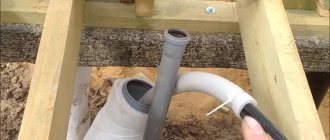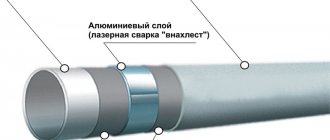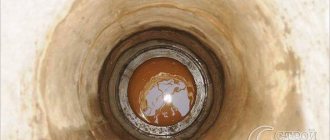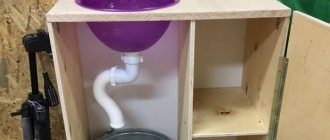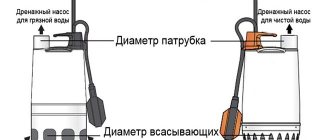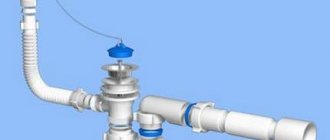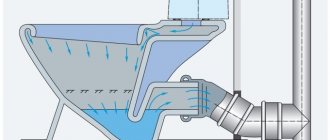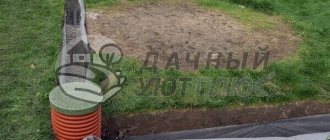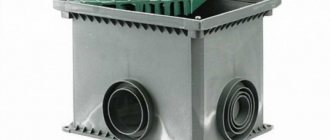Experienced builders and country residents know well that “excess” water on the site is bad. Excess water leads to flooding of the foundation and basement floor, washout of the foundation, flooding of beds, swamping of the area, etc. As a result, in spring, autumn and even summer you cannot walk around your summer cottage without rubber boots.
In this article we will look at:
- How to arrange water drainage on the site.
- How to make a budget storm drain with your own hands.
- Drainage device. How to make inexpensive drainage and drain a wetland.
What kind of water interferes with the life of a developer and a country homeowner?
A whole book could be written about the types of surface and ground water, as well as drainage and storm sewer systems. Therefore, we will leave beyond the scope of this article a detailed listing of the types and causes of groundwater occurrence, and will concentrate on practice. But without minimal theoretical knowledge, starting to independently arrange drainage and storm sewer systems is throwing money away.
The fact is that even an incorrectly designed drainage system functions for the first few years . Then, due to clogging (siltation) of the drainage pipe, wrapped in geotextile, which was placed in clayey, loamy, etc. soil, drainage stops working. But money has already been spent on drainage construction and, most importantly, drainage construction involves a large amount of excavation work involving equipment.
Therefore, simply digging up and relaying a drainage pipe 3-5 years after it was laid is difficult and costly. The site has already been inhabited, landscaping has been done, a blind area has been arranged, a gazebo, a bathhouse, etc. have been installed.
You will have to rack your brains on how to redo the drainage so as not to ruin the entire area.
Hence, the construction of drainage should always be based on data from a geological study of the soil (which will help to find a waterproof layer in the form of clay at a depth of 1.5-2 m), hydrogeological surveys and clear knowledge of what kind of water leads to flooding of a house or waterlogging of an area.
Surface waters are seasonal in nature, associated with the period of snowmelt and abundance of rain. Groundwater is divided into three main groups:
- Capillary water.
- Ground water.
- Verkhovodka.
Moreover, if surface water is not drained in time, it turns into underground water when infiltrated (absorbed) into the ground.
The volume of surface water usually exceeds the volume of groundwater.
Conclusion: surface runoff should be drained away by storm (rain) sewerage, and not try to create surface drainage!
Storm drainage is a system consisting of trays, pipes or ditches dug in the ground, discharging water from drains outside the site + competent organization of the relief on the personal territory. This will allow you to avoid stagnant zones on the site (lenses, pools), where water will accumulate, which simply has nowhere to go, and further waterlogging.
The main mistakes that are made when installing drainage yourself:
- Failure to maintain the correct slope of laid drainage pipes. If we take an average, then the slope is maintained in the range from 0.005 to 0.007, i.e. 5-7 mm per 1 running meter of drainage pipe.
- Using a drainage pipe in a geotextile wrap on “wrong” soil. To avoid siltation, pipes in geotextiles are used on soils consisting of clean medium- and coarse-grained sands.
- Using cheaper crushed limestone instead of granite, which is washed away by water over time.
- Saving on high-quality geotextiles, which must have certain hydraulic properties that affect the quality of drainage. This is an effective pore size of 175 microns, i.e. 0.175 mm, as well as transverse Kf, which should be at least 300 m/day (with a single pressure gradient).
On clay soils
Not all types of soil drain water well. These include clayey ones. Clay soil is characterized by an excess of moisture. Because of this, the required amount of oxygen does not reach the roots. As a result, the plants die. Dense turf also leads to oxygen starvation of plants.
When arranging a drainage system for a small area, it is not necessary to make calculations during the design process. In this case, it is necessary to take into account the parameters regarding drains:
- slope;
- location according to plan;
- depth;
- distance between rows;
- arrangement of wellhead and inspection wells.
It is better to use the natural terrain of the site with a slope when constructing a drainage system.
Using terrain
Laying in clay soil
It is easier to work with a sloping area than with a flat one. This is due at least to a reduction in labor costs. All you need is to correctly combine open and closed drainage.
Clay soil is dense and heavy, so to improve drainage properties the soil should be thoroughly loosened. In the process of laying drains, it is necessary to bypass places intended for vehicle passage.
Inexpensive do-it-yourself storm drain
The first thing that comes to mind in order to equip a budget option for storm drainage on a site is to lay special trays.
Trays can be made of concrete or plastic, but they are expensive. This forces users of our portal to look for cheaper options for installing storm drainage and drainage systems from the site.
Denis1235FORUMHOUSE Member
I need to make an inexpensive storm drain, about 48 m long, along the edge of the fence, to drain the melt water that comes from the neighbor. The water must be drained into a ditch. I was wondering how to drain the water. At first it occurred to me to buy and install special trays, but then they would be left with “extra” grates, and I don’t need any special aesthetics for the storm drain. I decided to buy asbestos-cement pipes and saw them lengthwise with a grinder, thereby getting a homemade tray.
Despite the budgetary nature of this idea, the user was not attracted to the need to cut asbestos-cement pipes on his own. The second option is the opportunity to buy gutters (plastic or metal) and lay them on a prepared base in a concrete layer of about 100 mm.
Users of the portal dissuaded Denis1235 from this idea in favor of the first option, which is more durable.
Having latched on to the idea of an inexpensive storm drain, but not wanting to deal with cutting pipes on his own, Denis1235 found a factory that produces asbestos-cement pipes, where they will immediately be sawed into pieces 2 m long (so that the 4-meter one does not crack during transportation) and ready-made trays will be delivered to the site . All that remains is to develop a scheme for laying the trays.
The result is the following “pie”:
- Soil base in the form of a bed.
- A layer of sand or ASG about 5 cm thick.
- Concrete about 7 cm.
- Tray made of asbestos-cement pipe.
When installing such a storm drain, do not forget to lay a metal mesh (for reinforcement) at the joints and leave a deformation gap (3-5 mm) between the trays.
Denis1235
As a result, I made a budget rain shower at the dacha. It took 2 days to dig the trench, another two days to pour concreting and install the route. I spent 10 thousand rubles on trays.
If we calculate at 2021 prices, then for 1 linear meter of a tray cut from an asbestos-cement pipe it cost about 200 rubles.
Practice has shown that the route “overwintered” well, did not crack and intercepts water from its neighbor, leaving the area dry. Also interesting is the option of a rainwater drainage system for a portal user with the nickname yury_by.
yury_byFORUMHOUSE Member
Because The crisis doesn’t seem to be ending, then I started thinking about how to install a storm drain to drain rainwater away from the house. I want to solve the problem, save money, and do everything efficiently.
After some thought, the user decided to make a storm drain for water drainage based on flexible double-walled corrugated pipes (they cost 2 times less than “red” sewer pipes), which are used for laying power cables underground. But, because The depth of the drainage route is planned to be only 200-300 mm with a pipe diameter of 110 mm, yury_by was afraid that the corrugated pipe might break in the winter if water gets between the two layers.
As a result, yury_by decided to take a budget “gray” pipe, which is used when installing internal sewerage. Although he had concerns that the pipes, which were not as rigid as the “red” ones, would break in the ground, practice has shown that nothing happened to them.
yury_by
If you step on the “gray” pipe, it turns into an oval, but there are no significant loads in the place where I buried it. The lawn has just been laid and there is foot traffic. Having laid the pipe in the trench and sprinkled it with soil, I made sure that they kept their shape and the storm drain was working.
The user liked the option of installing an inexpensive storm drain based on “gray” sewer pipes so much that he decided to repeat it. All the nuances of the process are clearly demonstrated by the following photographs.
We dig a hole for a drainage well to collect water.
Level the base.
We install a concrete ring.
The next stage is to fill the bottom of the well with gravel of fraction 5-20.
We cast a homemade well cover from concrete.
We paint the manhole cover.
We insert a drainage plastic “gray” sewer pipe into the well, maintaining a slope of 1 cm per 1 linear meter.
We spill the pipe with a mixture of sand and water so that there are no voids left between the walls of the trench and the pipe.
To prevent the pipe from floating, it can be pressed down with a brick or board.
We put the lid on, install the hatch and fill everything with soil.
This completes the production of the budget rain shower.
Is it possible to fill a drainage pipe with sand only?
We said above that a mandatory component of the drainage system is a coupling filled with crushed stone or other coarse material. A drain is placed in it, and the whole thing is sprinkled with sand.
And here the question arises: what if you don’t use crushed stone, but simply lay a pipe and fill it with sand? After all, ordering crushed stone is an additional expense (crushed stone and sand are mined in different quarries, so they need to be transported on separate flights).
Let's say right away: it is possible. And here there are two options:
- The first one will be cheaper, but less effective
- The second is more expensive, but more reliable
Economy option
For this, a corrugated drainage pipe is used. Before backfilling, it should be wrapped in geotextile or fibrous material to prevent small particles from clogging the holes.
The technology of filling sand over a pipe without crushed stone is not very reliable, although it is more economical. Due to the lack of coarse material, water will be drained more slowly; In addition, geotextiles in this case quickly silt. In winter, the moisture contained in the sand will freeze and begin to increase in volume. This will damage the pipe. To be fair, we note that crushed stone is also susceptible to freezing and can be destroyed at low temperatures. However, its frost resistance is much higher, and it does not damage pipes.
The issue of saving here is very controversial. In fact, you will only win by not having to pay for the delivery of crushed stone. But you will have to order more sand. And the system itself will be ineffective.
Therefore, we suggest considering another option. It is more expensive, but much more reliable.
Complete sand drainage without crushed stone
Nowadays more modern modifications of drainage are used, which can be laid with sand without crushed stone. These are pipes with a diameter of 10-20 cm, wrapped in a sleeve made of foam balls and geotextiles. To give the structure greater strength, they are equipped with additional stiffening ribs. Such drainage is not subject to freezing, can withstand heavy loads and lasts for decades.
The diameter of the pipe is 10-20 cm, together with the foam coupling - about 30 cm. The length of one section is 3 meters, but it can be cut. The pipes are connected to each other and placed in a trench, covered with sand and soil on top. The most famous brands are SoftRock and LiteRock. The cost of such pipes is higher than conventional ones. But they are easier to install and last longer, and you don’t have to spend money on crushed stone.
Next we will look at which sand is best suited for backfilling drainage systems.
Construction of low-cost drainage and drainage of wetlands
Not everyone gets the “right” plots. In SNT or in new cuts, the land may be very swampy, or the developer may have a peat bog. To build a normal house for permanent residence on such land, and not a light summer cottage, is both difficult and expensive. There are two ways out of this situation - sell/exchange the plot or start draining and putting the plot in order.
In order not to deal with various expensive alterations in the future, users of our portal offer budget options for drainage and drainage of the territory based on car tires. This option allows you to save your family budget.
Yuri PodymakhinForumHouse Member
Peat soil is characterized by a high groundwater level. On my site, the water is almost level with the surface, and after rain it does not go into the ground. To drain the top water, it must be thrown outside the site. I didn’t spend money on buying special pipes for drainage, but made drainage from car tires.
The system is installed as follows: a ditch is dug, tires are placed in it, and the tires are covered with polyethylene on top so that the earth from above does not fall in. Polyethylene can also be additionally pressed with pieces of slate that are “unnecessary” in the household. This will increase the overall rigidity of the structure. Water enters the “tire” pipeline and is then discharged outside the site.
But there are also “harder” places where much more needs to be done.
Seryoga567 FORUMHOUSE Member
I have a plot in SNT with a total area of 8 acres. There is a building on the site that I plan to complete and expand. The place is very low. Because The drainage grooves for water disposal in SNT are in a deplorable state, where they are buried, littered or clogged, the water does not go anywhere. The water level is so high that you can draw water from the well with a bucket, holding it by the handle. In the spring, the water in the dacha sits for a long time, the area actually turns into a swamp and, if it dries out, it is only in the summer when it is very hot. Nobody wants to put the drainage ditches in order, so everyone floats. Therefore, I decided that it was useless to fight with my neighbors. You need to raise your site and find a way to dispose of all the “unnecessary” water from the site.
The matter was complicated by the fact that the village is inhabited, and it is impossible to drive the necessary heavy equipment onto the site to fill the perimeter. Digging an absorption well to go through the water-resistant layer and drain water into it, which then goes into the lower water-absorbing layers, is too expensive.
Moreover, for this you need to do a hydrogeological survey on the site, and there are no guarantees that this will help. There is simply no “extra” money for all the work. Therefore, Seryoga567 decided to manually enclose the site with a retaining wall made from used truck tires filled with sand. Then raise the already fortified area with the help of tires and create an embankment “island” and, thereby, cut off the area from the water that floods it.
The work ahead was titanic, but the user, working “with one helmet,” coped with it.
Seryoga567
I remember when they dug a well for me before raising the level of the site, the layers of soil went like this. First a fertile layer, about a meter, then loam, which is heterogeneous, viscous and damp, but not clay. At the end of the work, liquid mud of unknown composition and silt began to appear. In short, it’s just a disorder, not a soil, so the water has nowhere to go, and the area is always damp. Now that I've surrounded the perimeter of the property with a tire retaining wall and raised it, things have changed. As soon as the sun warms the earth, the water disappears before our eyes. In the spring, neighbors continue to walk around their properties in boots, but we, one might say, move around in simple slippers.
Let us add that the user made the foundation for a house and outbuildings, as well as a fence, based on tires.
From a small stack of tires (basically, waste material that would be given away for free at a tire shop), stacked on top of each other, you can make an inexpensive drainage well.
Summarizing
The practice of users of our portal suggests that a way out of any situation, even the most hopeless one, can be found. If you lack experience or self-confidence, you can always seek advice from experienced FORUMHOUSE members, who will always tell you what and how to do correctly during construction. And even without a large budget, with the right approach you can make a reliable and inexpensive storm sewer and site drainage system with your own hands.
A thread on FORUMHOUSE explains how to drain and drain a wetland. We also advise you to study the topic, which gives advice on choosing geotextiles for the drainage system.
Useful articles about the features of the drainage system of the foundation and site, the choice and independent installation of a drainage well, and what to do if the basement floods.
The videos contain the nuances of site drainage and tips on choosing drainage pipes.
